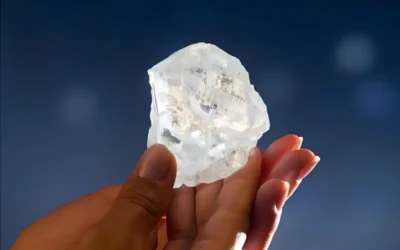Imagine owning a diamond larger than many famous natural stones—cultivated entirely in a lab. This isn’t science fiction: it’s happening today. Lab-grown diamonds have shattered size barriers, culminating in the 75.33-carat square-emerald cut graded as flawless Type IIa. Such giants prove that technology can rival nature, delivering premium-quality diamonds on demand. For consumers and industry alike, these milestones signal new luxury frontiers and prompt questions about value, ethics, and future growth. In this article, we’ll explore what defines a lab-grown diamond, delve into the record-breaking sizes achieved, reveal the science behind their creation, and examine the market ripples these gems are causing. Whether you’re a jeweler, brand owner, or diamond enthusiast, you’ll gain insights into the largest lab grown diamond phenomenon and what it means for the industry’s next chapter.
What Makes a Diamond “Lab-Grown”?
Lab-grown diamonds possess the same physical, chemical, and optical properties as mined ones but are  produced through two primary processes: CVD (Chemical Vapor Deposition) and HPHT (High Pressure-High Temperature).
produced through two primary processes: CVD (Chemical Vapor Deposition) and HPHT (High Pressure-High Temperature).
CVD: Chemical Vapor Deposition
CVD involves placing a diamond seed in a chamber filled with a hydrogen-methane gas mixture. Under controlled microwave plasma, methane molecules break down, and carbon atoms deposit onto the seed, building a diamond crystal layer by layer. This method allows precise control over growth rates and purity, enabling creation of nearly impurity-free diamonds ideal for large, flawless stones.
HPHT: High Pressure-High Temperature
HPHT emulates the earth’s deep-crust conditions by subjecting carbon to pressures above 5 GPa and temperatures exceeding 1,300 °C in specialized presses. Graphite transforms into diamond under these extremes. HPHT typically yields smaller crystals more rapidly than CVD, but advances have produced rough crystals exceeding 150 carats.
Measuring Size and Certification
Gem laboratories measure lab-grown diamonds by carat weight (200 mg per carat), cut quality, color, and clarity. Once cut and polished, diamonds are graded by independent bodies, which assess proportions, polish, symmetry, and identify growth origin. Certification ensures consumer confidence and accurate valuation.
Record-Breaking Largest Lab-Grown Diamonds
Lab innovations have produced several record holders, each pushing size limits.
The 75.33-Carat “Celebration of India”
Unveiled at a major 2024 trade show, this square-emerald cut gem began as a 190-carat rough grown over 270 days via CVD. After precision cutting, it was certified as a flawless Type IIa diamond with excellent polish and symmetry. The producer dubbed it the “Celebration of India,” showcasing leadership in high-end lab-grown gems.
The 34.59-Carat Faceted Milestone
Separately, a leading gemological institute examined a 34.59-carat emerald-cut CVD stone—the largest faceted lab-grown diamond it had ever seen. Produced in Mumbai, it measures roughly 25 × 14 × 9 mm and marked the first time a lab diamond crossed the 30-carat polished barrier.
Rough Giants: Up to 155 Carats
Beyond polished gems, researchers in Europe synthesized a single-crystal diamond disc weighing 155 carats with a 92 mm diameter after decades of R&D. Similarly, HPHT methods yielded a 150.42-carat rough crystal in late 2021. While these rough stones await cutting, they signal that even larger polished records are on the horizon.
How Are Giant Lab-Grown Diamonds Made?
Creating ultra-large lab-grown diamonds demands meticulous control and lengthy growth cycles.
Long-Duration CVD Growth
The 190-carat rough behind the 75.33-carat gem grew over approximately 270 days in a microwave plasma CVD reactor. Growth rates average 10–15 µm per hour, requiring uniform temperature and gas flow to avoid inclusions. Engineers continuously monitor pressure (20–30 Torr) and substrate temperature (800–1,100 °C) to maintain crystal integrity.
Scaling HPHT Techniques
HPHT presses compress graphite under pressures exceeding 5 GPa and temperatures above 1,300 °C, converting it to diamond in hours to days. Advances in multi-anvil and belt-press designs have increased chamber volumes, producing rough crystals over 100 carats. However, larger volumes pose challenges in heat dissipation and pressure uniformity, often requiring incremental scale-up trials.
Post-Growth Processing
After growth, rough diamonds undergo laser cutting and polishing. Expert lapidaries optimize facet angles to maximize brilliance and weight retention. Polishing a 75.33-carat gem can take weeks, as each facet demands nanometer-scale precision. Final grading confirms cut quality, color grade, and clarity, sealing its market value.
Case Study: Ethereal Green’s Breakthrough
Ethereal Green Diamond LLP’s “Celebration of India” exemplifies strategic innovation and marketing.
From Lab to Showcase
Beginning with a CVD reactor in Mumbai, Ethereal Green cultivated a 190-carat rough crystal over nine months. They then collaborated with expert cutters to produce a 75.33-carat square-emerald cut with exceptional symmetry and polish. Its certification at a major trade show lent instant credibility.
Branding and Market Impact
Named to honor India’s diamond heritage, “Celebration of India” debuted alongside a 30.69-carat ring-shaped stone, generating significant press and buyer interest. The reveal underscored lab-grown diamonds’ potential in high-luxury segments, challenging natural-diamond incumbents.
Design Collaboration
Ethereal Green partnered with a renowned design house to create an “Infinity Ring” featuring the 75.33-carat centerpiece flanked by smaller lab-grown stones. This collaboration demonstrated how lab-grown giants can anchor bespoke high-end jewelry, driving premium pricing and brand differentiation.
Comparing Lab-Grown vs. Natural Giants
Value Per Carat: How Do They Stack Up?
When comparing the largest lab grown diamond to natural ones, the first striking difference is the price. On average, lab-grown diamonds cost 60–90% less per carat. A natural 75-carat flawless diamond would be astronomically priced—likely exceeding $20 million—whereas the 75.33-carat lab-grown “Celebration of India” costs a fraction of that. Why the huge gap? Natural diamonds take billions of years to form under extreme pressure and are scarce at large sizes. Lab diamonds, while impressive in size and clarity, are now reproducible, which impacts their rarity and thus their value.
Resale, Investment, and Long-Term Worth
Natural diamonds, especially large and flawless ones, have a long-established resale and auction market. They often appreciate in value or hold their price over time, depending on market trends and provenance. In contrast, lab-grown diamonds are considered non-investment stones, with resale values typically dropping 50% or more immediately after purchase. For collectors or investors, this is a critical consideration. However, for consumers focused on beauty, ethics, and affordability, lab-grown diamonds provide tremendous upfront value.
Purity and Environmental Ethics
Interestingly, the largest lab grown diamonds are often purer than natural ones, especially when classified as Type IIa, which indicates a near-complete absence of nitrogen and other impurities. From an environmental standpoint, lab-grown diamonds avoid ecological damage from mining and reduce labor exploitation concerns. This eco-friendly angle is particularly attractive to younger, sustainability-conscious buyers who value transparency in sourcing.
In summary, natural diamonds maintain their edge in rarity and long-term investment potential, but lab-grown giants offer accessibility, ethical integrity, and a disruptive alternative for luxury buyers.
Market Implications and Future Outlook
Lab-Grown Diamonds Gain Market Share
Over the past five years, the lab-grown diamond sector has seen explosive growth, now accounting for approximately 20–25% of the global diamond jewelry market. As the size and quality of these stones have improved, they’ve gained credibility with consumers and retailers alike. Major online jewelers and luxury boutiques now offer lab-created options alongside natural stones, often using them to attract younger, value-driven shoppers.
The introduction of the largest lab grown diamonds has added a layer of prestige to the segment, challenging long-standing assumptions that only mined diamonds can be high-end or heirloom-worthy.
Strategic Shifts Among Traditional Players
Legacy mining companies and natural diamond suppliers initially downplayed lab-grown diamonds, viewing them as a threat to pricing power. But as consumer demand surged, many adapted. De Beers, for example, launched its own lab-grown line, while other miners have retreated from jewelry-grade synthetic diamonds, choosing instead to focus on the natural diamond narrative of rarity and romance.
Meanwhile, producers of lab-grown diamonds are investing in branding, storytelling, and even celebrity endorsements to elevate their perception and demand.
Innovation and Technological Arms Race
Behind the scenes, the race to grow even larger diamonds is heating up. Cutting-edge CVD reactors and HPHT presses are being tested for stability, efficiency, and purity control. Companies are now exploring multi-seed growth and rotational plasma chambers to achieve even larger, flawless single-crystal outputs. Some insiders believe we’ll see a 100-carat polished lab diamond in the next 1–2 years—making today’s giants merely a stepping stone.
As a result, the lab-grown segment isn’t just about affordability anymore. It’s becoming a center of innovation, luxury, and ethical leadership in fine jewelry.
What Buyers Should Know
Buying a large lab-grown diamond—especially one among the largest ever made—is a thrilling but complex purchase. Here’s what you need to know to make a smart, satisfying decision.
Certification Is Everything
When buying a diamond over 2 or 3 carats—let alone a 75-carat giant—certification is non-negotiable. Trusted grading labs like GIA, IGI, or GCAL provide detailed reports indicating whether a diamond is lab-grown or mined, along with color, clarity, and cut details. For the largest lab grown diamond purchases, these reports also include growth method (CVD or HPHT) and potential treatments. Always ask to see the certificate before making a purchase.
Don’t Skimp on the Cut
Large diamonds exaggerate flaws in proportion and polish. A poorly cut 10-carat diamond will look dull and lifeless, while a brilliantly cut 5-carat stone may outshine it. With lab-grown stones, buyers sometimes focus too much on size and forget that cut equals beauty. The same rule applies tenfold for diamonds over 20 or 30 carats.
Pricing and Budgeting
Lab-grown diamonds are more affordable than mined ones, but the price per carat rises with size and quality. For example, a 5-carat lab-grown diamond might cost $10,000–$20,000, while a 75-carat flawless one could exceed $500,000. Compare similar quality stones in smaller sizes to ensure you’re not overpaying simply for the wow factor.
Resale Expectations
Be realistic: lab-grown diamonds typically don’t hold resale value well, especially compared to natural diamonds. That said, if you’re buying for love, aesthetics, or ethics—not investment—it’s a small trade-off for an extraordinary stone.
Know Your Source
Verify that the lab-grown diamond is made using renewable energy sources if sustainability is a key concern for you. The most reputable producers disclose their environmental impact and power sources used during growth.
Conclusion
The era of largest lab grown diamonds has arrived, with flawless giants that rival—and sometimes surpass—the world’s finest natural stones. From the 75.33-carat “Celebration of India” to the 34.59-carat faceted milestone and 155-carat rough discs, technology is redefining gemological limits. These breakthroughs offer unprecedented value, ethical assurance, and design freedom, while prompting traditional miners to recalibrate their strategies. As CVD and HPHT processes evolve, expect even larger polished gems and expanding industrial applications—from luxury jewelry to cutting-edge electronics. For buyers, the opportunity to own a truly record-setting diamond at a fraction of natural prices has never been clearer, provided they navigate certification, cut quality, and resale considerations thoughtfully. The next frontier may see 100-carat polished lab-grown diamonds become mainstream—a testament to human ingenuity and the boundless possibilities of science.






